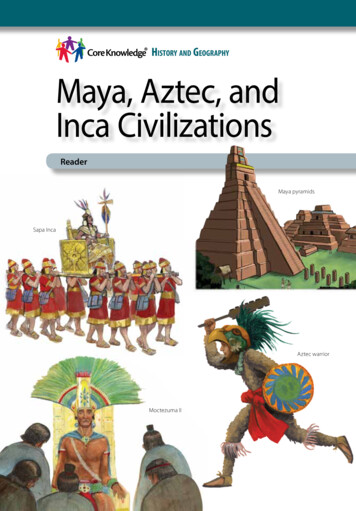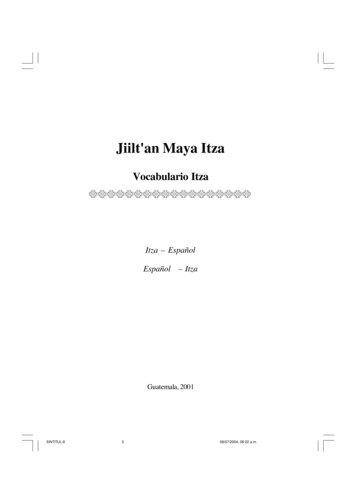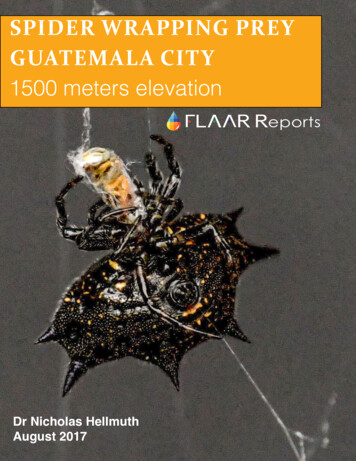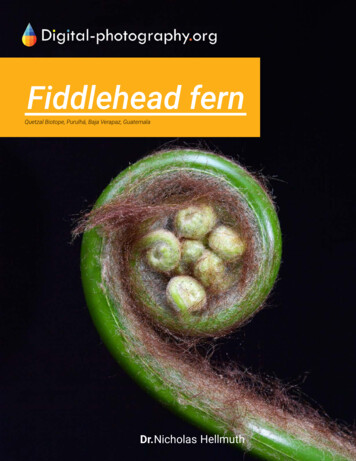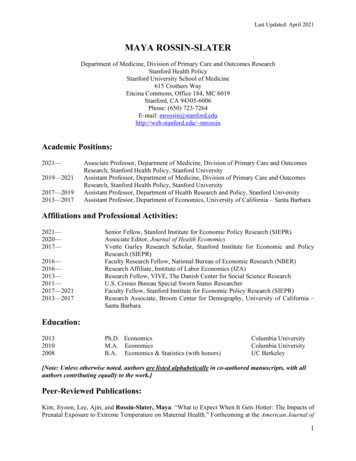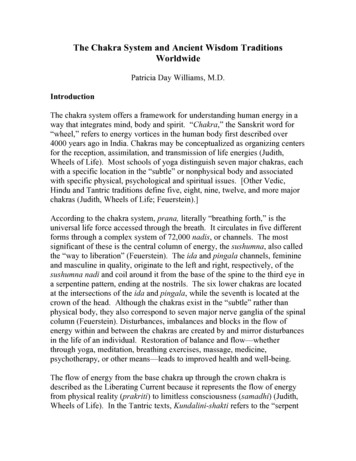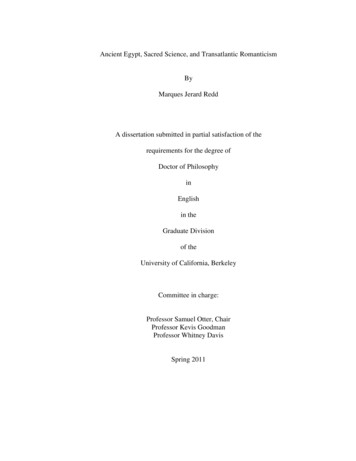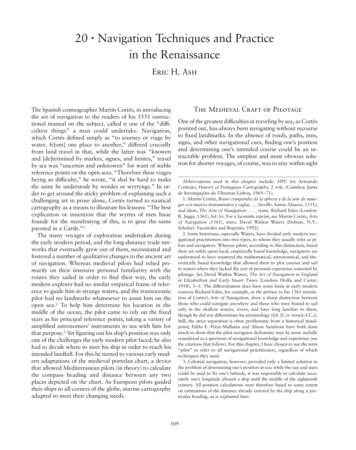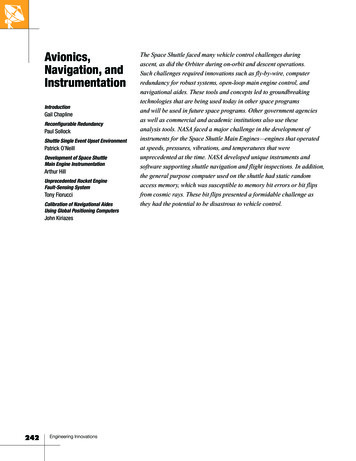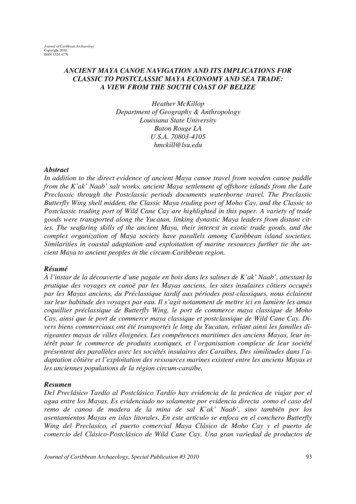
Transcription
Journal of Caribbean ArchaeologyCopyright 2010ISSN 1524-4776ANCIENT MAYA CANOE NAVIGATION AND ITS IMPLICATIONS FORCLASSIC TO POSTCLASSIC MAYA ECONOMY AND SEA TRADE:A VIEW FROM THE SOUTH COAST OF BELIZEHeather McKillopDepartment of Geography & AnthropologyLouisiana State UniversityBaton Rouge LAU.S.A. 70803-4105hmckill@lsu.eduAbstractIn addition to the direct evidence of ancient Maya canoe travel from wooden canoe paddlefrom the K’ak’ Naab’ salt works, ancient Maya settlement of offshore islands from the LatePreclassic through the Postclassic periods documents waterborne travel. The PreclassicButterfly Wing shell midden, the Classic Maya trading port of Moho Cay, and the Classic toPostclassic trading port of Wild Cane Cay are highlighted in this paper. A variety of tradegoods were transported along the Yucatan, linking dynastic Maya leaders from distant cities. The seafaring skills of the ancient Maya, their interest in exotic trade goods, and thecomplex organization of Maya society have parallels among Caribbean island societies.Similarities in coastal adaptation and exploitation of marine resources further tie the ancient Maya to ancient peoples in the circum-Caribbean region.RésuméÀ l’instar de la découverte d’une pagaie en bois dans les salines de K’ak’ Naab’, attestant lapratique des voyages en canoë par les Mayas anciens, les sites insulaires côtiers occupéspar les Mayas anciens, du Préclassique tardif aux périodes post-classiques, nous éclairentsur leur habitude des voyages par eau. Il s’agit notamment de mettre ici en lumière les amascoquillier préclassique de Butterfly Wing, le port de commerce maya classique de MohoCay, ainsi que le port de commerce maya classique et postclassique de Wild Cane Cay. Divers biens commerciaux ont été transportés le long du Yucatan, reliant ainsi les familles dirigeantes mayas de villes éloignées. Les compétences maritimes des anciens Mayas, leur intérêt pour le commerce de produits exotiques, et l’organisation complexe de leur sociétéprésentent des parallèles avec les sociétés insulaires des Caraïbes. Des similitudes dans l’adaptation côtière et l’exploitation des ressources marines existent entre les anciens Mayas etles anciennes populations de la région circum-caraïbe.ResumenDel Preclásico Tardío al Postclásico Tardío hay evidencia de la práctica de viajar por elagua entre los Mayas. Es evidenciado no solamente por evidencia directa como el caso delremo de canoa de madera de la mina de sal K’ak’ Naab’, sino también por losasentamientos Mayas en islas litorales. En este artículo se enfoca en el conchero ButterflyWing del Preclasíco, el puerto comercial Maya Clásico de Moho Cay y el puerto decomercio del Clásico-Postclásico de Wild Cane Cay. Una gran variedad de productos deJournal of Caribbean Archaeology, Special Publication #3 201093
Ancient Maya canoe navigationMcKillopcomercio fueron transportados a lo largo de la península de Yucatán, vinculando líderesdinásticos Mayas en ciudades distantes. Las competencias marítimas de los antiguos Mayas,su interés en el comercio de mercancías exóticas, y la compleja organización de la sociedadMaya tienen paralelismos entre las sociedades insulares del Caribe. Las similitudes en laadaptación a la costa y la explotación de los recursos marinos aún más vinculan losantiguos Mayas con los pueblos antiguos en la región del circum-Caribe.IntroductionAlthough some researchers have suggested there was travel and trade betweenthe Maya area and islands in the Caribbean(Harlow 2006; Wilson et al. 1998), there isno firm evidence. Morphological similarities in chert tools between the two areas(Wilson et al. 1998) may be explained bysimilar uses for the tools; moreover chert ischemically variable within outcrops and sochert artifacts have proven difficult tochemically characterize to particular locations, unlike obsidian, which is quite uniform in trace elements. The discovery of anew jadeite locality in Cuba (García-Cascoet al. 2009) provides a closer possiblesource for jadeite artifacts than the Motagua River valley of Guatemala, previouslyknown as the major source of jadeite andother greenstones used by the ancient Mayaand others throughout Mesoamerica andCentral America (Harlow 2009).The possibility of direct contact between people inthe Caribbean islands and the Maya arearemains possible, given the facility of boattravel in both areas, but there appears tohave been no significant cultural impacts.More important for archaeologists working in both areas, are the many similaritiesin the maritime economies that might benefit from more comparisons. The proximityto the sea meant that there often were similar adaptations in throughout the circumCaribbean area, including the coast of theMaya area. There was the shared practiceof negotiated political relations manifestedby feasting events, and the demand for rit-ual and status paraphernalia—such as jade,gold and exotic marine shell—by the dynastic Maya leaders and by Caribbean island chiefs. In this paper, I discuss the useand importance of the sea to the ancientMaya to provide a comparison for othercultures in the circum-Caribbean region.Maya Canoe Travel and TradeIsland communities, trade goods, andartistic depictions of canoe paddlers document that the ancient Maya were proficientcanoeists for travel and trade along rivers,on the sea around the Yucatan peninsula,and offshore (see McKillop 2006). The decentralized political structure of the Classicperiod civilization (AD 300-900) meantthat political power was brokered more bynegotiation than by the centralized authority backed by military force characteristicof some other ancient civilizations such asthe Aztec, Inca, or Teotihuacan (McKillop2006). Negotiated power was mediated bymovement of people and goods: Oxygenisotopes of bone of the founder of Copan,K’inich Yax K’uk’ Mo’, indicate he camefrom the west, likely the Tikal area(Buikstra et al. 2004). His depiction inTeotihuacan regalia with typical Teotihuacan “goggle eyes” on Altar Q at Copan underscores his affiliation with central Mexico (Sharer 2004). The dynamics of watertravel, particularly maritime trade, changedover time, reflecting the rise of complexityin the Late Preclassic (300 BC- AD 300),the Classic Maya civilization focused onthe interior of the southern lowlands, andJournal of Caribbean Archaeology, Special Publication #3 201094
Ancient Maya canoe navigationMcKillopFigure 1. Map of the Maya Area Showing Sites Mentioned in the Text (by Mary Lee Eggart, LSU).Journal of Caribbean Archaeology, Special Publication #3 201095
Ancient Maya canoe navigationthe Postclassic society focused in the northern Maya lowlands.The only direct evidence of canoe travelis the Late Classic wooden canoe paddlefrom the K’ak’ Naab’ saltwork in southernBelize (McKillop 2005a). However, various other lines of evidence indicate enduring water transportation by the ancientMaya. The earliest known inhabitants ofthe Maya area were Paleoindians, descendants of people who migrated from Asia atthe end of the Pleistocene, and then eitherskirted the glaciers by boat or followed anice-free corridor through the glacier andinto what is now mainland United States by11,500 years ago. They traveled farthersouth on foot, populating the Americaswithin a thousand years (Lohse et al. 2006;McKillop 2006).The earliest firm evidence of ancientcoastal canoe travel is documented by LatePreclassic settlement of the Maya islandsof Moho Cay and Cancun (Andrews et al.1974; McKillop 2004). Moho Cay was atrading port at the mouth of the BelizeRiver. Widespread Late Preclassic coastalsettlement on the coast of Belize and theYucatan peninsula of Mexico (see Eaton1978; Freidel 1979; McKillop 1989a)points to coastal travel and trade at thistime, although the coast may have beensettled by inland people who did not venture out to sea. Species of marine fish thatare not accessible from the shore are documented later at both coastal and inlandcommunities indicating boat travel (Emery2004; McKillop 1984, 1985).David Freidel (1979) makes a convincing argument for the rise of social complexity in the Late Preclassic at the coastalcommunity of Cerros in northern Belize,where coastal trade drove interregional interaction and exchanges of preciositiesamong elites. Late Preclassic or Protoclassic settlement at Butterfly Wing inMcKillopsouthern Belize (McKillop 1996) at themouth of the Deep River points to canoetravel, with obsidian linking the community to trade with the Maya highland outcrops of Ixtepeque and El Chayal(McKillop 2005b). There is another LatePreclassic shell midden on Cancun(Andrews et al. 1974). Early Classic settlement of Maya islands, including MohoCay, as well as Wild Cane Cay and PelicanCay in southern Belize, documents continuity of sea travel and trade (Figure 1).Classic Period Maya Sea TradeAlthough the geographic focus on theClassic Maya civilization was inland withdozens of cities and their polities, the seawas critical to their acquisition of salt andother marine resources, as well as a transportation avenue for goods and resourcesfrom farther away. The Paynes Creek saltindustry in southern Belize developed tomeet the biological demand for salt byMaya, as documented by trade goods frominland cities in Belize and adjacent Guatemala (McKillop 2005a). Unit-stamped pottery vessels and figurine whistles at thePaynes Creek salt works share styles withLubaantun in southern Belize, and communities farther west in adjacent Guatemala,notably Altar de Sacrificios, Seibal, and thePetexbatun (McKillop 2007a, 2008). Thesalt works were abandoned at the end ofthe Classic period when the market collapsed with the abandonment of the inlandcities.The coastal-inland connection of theClassic Maya civilization extended to otherresources, including seafood. Lange’s(1971) provocative model that seafood provided a protein base for the inland Mayahas some support: tuna bones from the central Belize coast were cut for drying or salting for storage or perhaps inland trade(Graham 1994); Valdez and Mock (1991)Journal of Caribbean Archaeology, Special Publication #3 201096
Ancient Maya canoe navigationregard salt production at Northern RiverLagoon in northern Belize as geared toward salting meat for inland trade, on thebasis of the presence of briquetage (potteryfrom boiling brine) and animal bones at thesite. Certainly isotopic evidence (White etal. 2001a) and marine resources at inlandcommunities (Emery 2004; McKillop1984, 1985, 2004, 2005b) document inlandtransport, but in limited quantities.The sea was central to the ritual ideologyof the Classic Maya. The sea was thesource of ritual paraphernalia includingstingray spines for bloodletting, hallucinogenic secretions from the Bufo marinusfrog, and imagery equating the sea with theunderworld and creation (McKillop2005b). The sea also was a transportationavenue for goods and resources from farther away, including obsidian, jadeite, andpottery. Inland trails and rivers clearlywere central to the movement of goods andpeople. Chemical analyses of the bones ofYax K’uk’ Mo’ indicate he originated fromthe west, likely Tikal (Sharer et al. 2004).His depiction with goggles and Teotihuacan regalia on Altar Q - a carved stone withimages of dynastic leaders of Copan - linkhim with Teotihuacan, suggesting complexpolitical ties beyond the Maya area. An Altun Ha pottery vessel in a Late Classic burial from Copan likely represents a gift during a meeting between dynastic leaders ortheir representatives, cementing a trade,marriage or other alliance. Chemical analysis of human bone and teeth from an AltunHa individual buried with green obsidianfrom the Pachuca source in central Mexicoand chipped into Teotihuacan style figuresindicated the person was from Altun Ha.He was not a foreigner. This informationsuggests the gift was made during a royalvisit and was ultimately interred with therecipient (White et al. 2001b).The expansion of coastal Maya settle-McKillopment in the Late Classic period, the abundance of trade goods, including obsidian, atcoastal sites, all the inland Maya demandfor coastal resources and goods from moredistant lands, point to canoe transport in theLate Classic. The Late Classic demand forobsidian at inland Maya sites in the southern lowlands was largely met by the Mayahighland sources of El Chayal and Ixtepeque (Braswell 2004; Dreiss and Brown1989; McKillop 1989b; Nelson 1980).Much of the obsidian was transported fromthe Maya highlands, down the MotaguaRiver, and then north along the coast ofBelize (Hammond 1972; Healy et al. 1984;McKillop et al. 1988), passing the tradingports of Wild Cane Cay (McKillop 2005b),False Cay (Graham 1994), Placencia(MacKinnon 1989), Moho Cay (McKillop2004), Marco Gonzalez (Graham andPendergast 1989) and San Juan (Guderjanand Garber 1995) on Ambergris Cay, andSanta Rita on the mainland coast (Chaseand Chase 1989; McKillop 2005b; McKillop and Healy 1989), connecting withcoastal ports around the Yucatan, such asIsla Cerritos (Andrews et al. 1989).The coast may have been used to acquiregoods from farther away in the Classic period. They include a tumbaga (gold alloy)artifact from Altun Ha (Pendergast 1970),mercury from under a ball court marker atLamanai (Pendergast 1982), and jadeitefrom the Motagua River outcrops, marineshells from the Pacific (Feldman 1974),and obsidian from central Mexico (Spence1996).The Classic Maya Trading Port on MohoCayThe island trading port on Moho Caywas well situated to participate in coastalinland trade up the Belize River, sea tradealong the coast, and the exploitation of estuarine resources in the coastal watersJournal of Caribbean Archaeology, Special Publication #3 201097
Ancient Maya canoe navigation(McKillop 1984, 2004). Moho Cay is located in the mouth of the Belize River,which provides access to communities inwestern Belize and the Peten District ofGuatemala. Although only one field seasonof excavation was possible at the site sinceit was destroyed for tourism developmentprior to the planned second field season,research indicates Moho Cay was a permanent settlement dating from the Late Preclassic through the Postclassic periods. Excavations revealed burials associated withEarly Classic Tzakol 3 and Late ClassicTepeu 1 and 2 pottery characteristic of thePeten region. People were buried underhouses of perishable pole and thatch.A variety of goods and resources broughtto the island by boat, either from directprocurement or trade, indicate enduringreliance on waterborne transportation bythe Moho Cay Maya (McKillop 2004). Imported stone tools include grey obsidianfrom the Maya highland outcrops of ElChayal and Ixtepeque (Healy et al. 1984),greenstones likely from the Motagua Riverbasin of Guatemala, and high quality chertfrom the Colha region of northern Belize.A midden dominated by manatee(Trichechus manatus) and queen conch(Eustrombus gigas; McKillop 1984), underscore facility with boat travel andknowledge of the sea. Stylistic similaritiesof the pottery lie with ceramics from AltunHa and the Peten region.Maya Canoe TravelAlthough both the inland and coastalMaya had knowledge of canoes, travel onthe sea required specialized knowledge ofcurrents, weather, shoals, and navigationlikely only known to the coastal Maya.Inland canoe travel along rivers in smallpaddling canoes is depicted incised onbones from Tikal’s burial 116, Temple 1(Trik 1963). River travel requires knowl-McKillopedge of currents, such as paddling upstream close to shore in the rainy seasonwhen the rivers are flooded and there arestrong downstream currents. In contrast,the sea has more hazards, including lack ofshoreline visibility, a greater expanse ofavailable travel, hidden shoals and fauna,and heavy seas and bad weather (McKillop2005b). Control of the sea by the coastaland island Maya would have given themcontrol of the production and distributionof maritime resources (such as salt, stingray spines, shells, and seafood) and tradegoods from farther away. Goods weretraded along the coast within the Mayaarea, such as Maya highland obsidiantransported along the coast or an Altun Haemissary bearing gifts to a Copan dynasticleader. The sea may have been used totransport goods from farther away, such astumbaga gold from Central or South America traded to Altun Ha (Pendergast 1970).Sea Faring in the Caribbean and MayaAreasWere the Caribbean and Maya areaslinked during the Classic Maya period bytrading ventures, perhaps traders sent asemissaries as in the later Aztec pochteca?Both in the Maya and broader circumCaribbean areas, including the Caribbeanislands and the “intermediate area” oflower Central America, political power wasmediated by negotiations marked by feasting events where gifts were exchanged. Inlater times, the Aztec pochteca (longdistance traders) exchanged gifts from theAztec king with political leaders outsidethe Aztec empire. The pochteca and theirking were looking for resources of interestthat could be acquired either by negotiatingtrade alliances or by conquest and tributepayment, such as chocolate in the Soconusco area of Pacific Guatemala(Voorhies 1989). The greater the travel dis-Journal of Caribbean Archaeology, Special Publication #3 201098
Ancient Maya canoe navigationtance, the more likely trade alliances werenegotiated, due to difficulties of controllinggeographically distant areas by militaryforce.The Rise of Postclassic Maya Sea TradeThe sea became a major transportationavenue for the Postclassic Maya. Followingthe collapse of the dynastic Maya politiesin the southern lowlands by AD 900, thecoastal-inland relationship ended—at leastin the southern Maya lowlands. The coastaland island Maya developed new allianceswith emerging polities in the northernMaya lowlands, first at Chichen Itza andTulum, and then at Mayapan. The place ofcoastal Maya within the negotiated political economy of the inland Maya dynasticpolities ended. The Postclassic witnessednew opportunities and new alliances: Therewere independent coastal polities such asWild Cane Cay (McKillop 2005b) andthose linked to nearby inland polities suchas Isla Cerritos’ alliance with Chichen Itza(Andrews et al. 1989). The outward perspective of Postclassic Maya politics contrasted sharply with the inward perspectiveof the Classic polities of the southern Mayalowlands. Although the Classic Mayatraded extensively outside the Maya area,developed complex relations with Teotihuacan, and participated in coastal trade,the population was overwhelmingly in theinterior of the Yucatan, focused on an agricultural economy, and predicated on negotiated alliances, including raids and battles,among inland polities. With the abandonment of most inland cities and the collapseof the political economy of the southernlowlands, the existing coastal transportation routes were used by coastal communities and ports, expanding and re-directingvirtually all long-distance, even medium toshort distance, trade along the coast.McKillopPostclassic Trading Port on Wild CaneCayThe trading port of Wild Cane Cay expanded exponentially after the ClassicMaya collapse and the collapse of thePaynes Creek salt industry (McKillop1989b, 1996, 2005b). During the LateClassic, Wild Cane Cay likely controlledthe inland transport of salt from the PaynesCreek salt works (McKillop 2005a). Therewas an 800% increase in the amount of obsidian traded to Wild Cane Cay that wasleft at the port, likely as payment for services such as housing traders, docking andwarehousing (McKillop 1989b). Polyhedralobsidian cores were transported to WildCane Cay with prismatic blades producedfor local distribution to surrounding coastalcommunities (McKillop 1996). The lack ofconservation of this scarce resource in theproduction of blades (as measured by bladewidth and also by the cutting edge to massratio), as compared to other Maya communities, underscores the regular supply and/or availability of obsidian at Wild CaneCay (McKillop 2005b).The Postclassic Maya on Wild Cane Caysecured their place in the geopolitics ofMaya society as autonomous traders. Theyconstructed stone architecture using coralrock as foundations (McKillop 2005b;McKillop et al. 2004). Excavations inFighting Conch mound revealed six buildings with individuals interred with a varietyof exotic trade goods that marked theirplace in a sea trade economy: A youngwoman from burial 10 was interred in thebound-captive position depicted on Mayapainted pots (on her stomach with her legsfolded and hand and foot bones commingled behind her back). She was not buriedin a tomb like other Fighting Conch burials, but directly on the floor of a demolished building. She was placed as a dedication to the next building, with coral rockJournal of Caribbean Archaeology, Special Publication #3 201099
Ancient Maya canoe navigationfoundation of the subsequent structureplaced on top of her grave. She was buriedMcKillopwith a Las Vegas polychrome vessel imported from Honduras (Figure 2).Figure 2. Trade Pottery from the Maya Trading Port of Wild Cane Cay, Belize. a), Las Vegas Polychromefrom Honduras excavated from Fighting Conch burial 10; b) Tulum Red (Payil Red) excavated from FightingConch burial 11/12; c) Tohil Plumbate from Pacific Guatemala (unprovenienced).Journal of Caribbean Archaeology, Special Publication #3 2010100
Ancient Maya canoe navigationAnother grave from Fighting Conchmound is that of a young man buried in ahearth with three stones, reminiscent of theMaya ideology of creation and celestialnavigation: The man was buried in a seatedposition in a rock hearth, on a bed of charcoal, but not burned. In the ashes below thewood charcoal there were three trade goods(obsidian, chert, and groundstone) identifying him as a trader, but importantly alsolinking him to the three hearthstones of theMaya creation story, which also are thethree stars that mark the constellationOrion (Freidel et al. 1995; McKillop2005b: Figures 6.25-6.26); Tedlock1986)—surely used in the past for sea navigation.The individual in burial 8 in FightingConch mound was interred with a TerminalClassic, gouge-incised vessel reminiscentof Fine Orange (McKillop 2005b: Figure6.19), with gold foil in the finger coral intowhich the rock tomb was placed. Gold foilis only known from a handful of Postclassic Maya communities, linking WildCane Cay to a trade with lower CentralAmerica or South America (McKillop2005b).Burial 11/12 was accompanied by a Tulum Red (or Payil Red) vessel, stylisticallyidentical to vessels from Tulum and sites innorthern Belize, such as Lamanai andColha (McKillop 2005b: Figure 6.31). Tiesto the Pacific coast of Guatemala includeTohil Plumbate pottery from the Pacificcoast of Guatemala (Figure 2).The coastal Maya, like the Caribbeanisland settlers, were expert at canoe navigation and the exploitation of maritime resources. The Wild Cane Cay Maya ventured offshore to mainland rivers for the“jute” snails (Pachychilus sp.), a highlydesired food (Healy et al. 1990). Armadillos, paca, and peccary were hunted fromthe mainland. Estuarine resources includedMcKillopmanatee, snappers, barracuda, groupers,and a variety of shells. Reef species included parrotfish and doctor fish availablefarther offshore on reefs and saltier seas.Shells were abundant, with most speciesavailable nearby but deeper water speciesalso present, such as a Spondylus sp. Shelldisk in a child’s burial from FightingConch mound (McKillop 2005b: Figure6.32a). The diversity and abundance of marine resources attests to the boating skillsand knowledge of fishing as well as awareness of the dangers and potential of theseas as a food basket. The outward worldview of the Postclassic Maya, their expertise in sea trade and travel, and the demandfor exotics opened a world only surpassedby the arrival of the Spaniards in the sixteenth century.ConclusionsThe coastal Maya were proficient seafarers, with the K’ak’ Naab’ canoe paddleproviding direct evidence of canoe travel.The Late Preclassic provides the first clearevidence of sea trade, with island settlement on Cancun and Moho Cay, as well asthe coastal settlements of Cerros and Butterfly Wing. The Classic period witnessedthe development of coastal-inland traderelations, with the coastal Maya supplyingmarine resources, ritual paraphernalia tounderwrite the ideology of the Maya, and alink to sea trade for resources from fartheraway. There was an expansion of sea tradeafter the collapse of the inland polities inthe southern Maya lowlands. Some tradingports like Isla Cerritos became ports forinland cities, whereas others, like WildCane Cay, developed into autonomouscoastal polities. The opportunistic coastalMaya entered a new era of sea trade, linking a wider world of Mesoamerica andCentral America.Journal of Caribbean Archaeology, Special Publication #3 2010101
Ancient Maya canoe navigationAcknowledgementsMy ideas in this paper are based on fieldresearch carried out under permits fromthe Belize Institute of Archaeology, forwhich I am grateful.References CitedAndrews, A. P., F. Asaro, H. V. Michel, F.H. Stross, and P. Cervera Rivero1989 The Obsidian Trade at Isla Cerritos,Yucatan, Mexico. Journal of FieldArchaeology 16: 355-363.Andrews IV, E. W., M. P. Simmons, E. S.Wing, E. W. Andrews V.1974 Excavation of an Early Shell Midden on Isla Cancun, Quintana Roo,Mexico. Middle American Research Institute Publication 31.New Orleans: Tulane University.Braswell, G.2004 Lithic Analysis in the Maya Area.In Continuities and Change in theMaya Area: Perspectives at theMillennium, edited by C. Goldenand G. Borgstede, pp. 177-200.New York: Routledge.Buikstra, J. E., T. Douglas Price, L. E.Wright, and J. A. Burton2004 Tombs from the Copan Acropolis:A Life History Approach. In Understanding Early Classic Copan,edited by E. E. Bell, M. A. Canuto,and R. J. Sharer, pp. 191-212.Philadelphia: University of Pennsylvania Museum of Archaeologyand Anthropology.Chase, A. F., and D. Z. Chase1989 Routes of Trade and Communication and the Integration of MayaSociety: The Vista From Santa RitaCorozal, Belize. In Coastal MayaTrade, edited by H. McKillop andP. F. Healy, pp. 19-32. OccasionalPublication in Anthropology 8.McKillopPeterborough: Department of Anthropology, Trent University.Dreiss, M., and D. O. Brown1989 Obsidian Exchange Patterns in Belize. In Prehistoric Maya Economies of Belize, edited by P.McAnany and B. L. Isaac, pp. 5790. Research in Economic Anthropology, supplement No 4. Greenwich: JAI Press.Eaton, J. D.1978 Archaeological Survey of the Yucatán-Campeche Coast. MiddleAmerican Research Institute, Publication 46(1). New Orleans: TulaneUniversity.Emery, K. (ed.)2004 Maya Zooarchaeology: New Directions in Method and Theory. LosAngeles: Cotsen Institute of Archaeology, University of California.Feldman, L.1974 Shells from Afar: 'Panamic' Mollusks in Mayan Sites. In Mesoamerican Archaeology: New Approaches, edited by N. Hammond,pp. 129-134. London: Duckworth& Company.Freidel, D. A.1979 Culture Areas and InteractionSpheres: Contrasting Approaches tothe Emergence of Civilization inthe Maya Lowlands. American Antiquity 44: 36-54.Freidel, D. A., L. Schele, and J. Parker1995 Maya Cosmos. New York: Harper.García-Casco, A., A. Rodríguez Vega, J.Cárdenas Párraga, M. A. Iturralde-Vinent,C. Lázaro, I. Blanco Quintero, Y. RojasAgramante, A. Kröner, K. Núñez Cambra,G. Millán, R. L. Torres-Roldán, S.Carrasquilla2009 A new jadeitite jade locality (Sierradel Convento, Cuba): first reportand some petrological and archaeo-Journal of Caribbean Archaeology, Special Publication #3 2010102
Ancient Maya canoe navigationlogical implications. Contributionsto Mineral Petrology 158: 1-16.Graham, E. A.1994 The Highlands of the Lowlands: Environment and Archaeology in theStann Creek District, Belize, Central America. Monographs in WorldArchaeology 19. Madison: Prehistory Press.Graham, E. A., and D. M. Pendergast1989 Excavations at the Marco GonzalezSite, Ambergris Cay, Belize, 1986.Journal of Field Archaeology 16: 116.Guderjan, T. H., and J. F. Garber (eds)1995 Maya Maritime Trade, Settlement,and Population on Ambergris Caye,Belize. Culver City: LabyrinthosPress.Hammond, N,1972 Obsidian Trade Routes in theMayan Area. Science 178: 10921093.Harlow, G., A. R. Murphy, D. J. Hozjan, C.N. de Mille and A. A. Levinson2006 Pre-Columbian Jadeite Axes FromAntigua, West Indies: Descriptionand Possible Sources. The CanadianMineralogist 44: 305-321.Healy, P. F., H. McKillop, and B. Walsh1984 Analysis of Obsidian from MohoCay, Belize: New Evidence on Classic Maya Trade Routes. Science225: 414-417.Healy, P. F., K. Emery, and L. Wright1990 Ancient and Modern Maya Exploitation of the Jute Snail, Pachychilus.Latin American Antiquity 1: 170183.Lange, F. W.1971 A Viable Subsistence Alternativefor the Inland Maya. AmericanAnthropologist 73: 619-639.McKillopLohse, J. J. A., C. Griffith, R. M.Rosenswig, and F. Valdez, Jr.2006 Preceramic Occupations in Belize:Updating the Paleoindian and Archaic Record. Latin American Antiquity 17: 209-226.MacKinnon, J. J.1989 Coastal Maya Trade Routes inSouthern Belize. In Coastal MayaTrade, edited by H. McKillop andP. F. Healy, pp. 111-122. Occasional Publication in Anthropology8. Peterborough: Department ofAnthropology, Trent University.McKillop, H.1984 Ancient Maya Reliance on MarineResources: Analysis of a Middenfrom Moho Cay, Belize. Journal ofField Archaeology 11: 25-35.1985 Prehistoric Exploitation of theManatee in the Maya and CircumCaribbean Areas. World Archaeology 16: 338-353.1989a Development of Coastal MayaTrade: Data, Models, and Issues. InCoastal Maya Trade, edited by H.McKillop and P. F. Healy, pp. 1-17.Occasional Publication in Anthropology 8. Peterborough: Department of Anthropology, Trent University.2004 The Classic Maya Trading Port ofMoho Cay. In The Ancient Maya ofthe Belize Valley, edited by J. F.Garber, pp. 257-272. Gainesville:University Press of Florida.2005a Finds in Belize document LateClassic Maya salt making and
Maya to provide a comparison for other cultures in the circum-Caribbean region. Maya Canoe Travel and Trade Island communities, trade goods, and artistic depictions of canoe paddlers docu-ment that the ancient Maya were proficient canoeists for travel and trade along rivers, on the sea around
